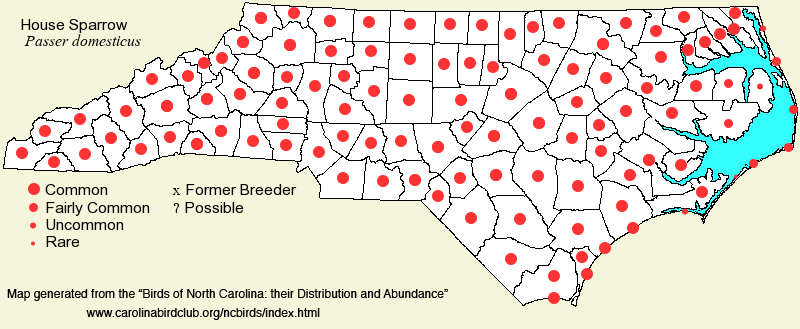 |  |
|
House Sparrow - Passer domesticus Sole representative of PASSERIDAE in NC | Search Common: Search Scientific: |
|
|
|||||||
| General Comments | The House Sparrow, introduced from Europe into New York City around 1850, spread quickly across the North American continent, such that it has been established in all states and much of Canada and Latin America since the early parts of the 20th Century. In North Carolina, it is common to very common in urban and farm areas, being scarce only at higher elevations, in deep forested areas, and on some barrier islands. The fairly recent (1960's through 1980's) spread of the House Finch across the East, also from an introduction, seems to have slightly impacted the House Sparrow, though both species are still overly numerous near man. Nonetheless, there seems to be a slight decline in numbers of House Sparrows statewide in recent years, which is good news for any non-native plant or animal species; one must often look for them around fast-food establishments and other places in cities and towns where food is served and is disposed of outdoors. | ||||||
| Breeding Status | Breeder; Introduced | ||||||
| NC BRC List | Definitive | ||||||
| State Status | |||||||
| U.S. Status | |||||||
| State Rank | SE | ||||||
| Global Rank | G5 | ||||||
| Coastal Plain | Permanent resident; seemingly non-migratory. Common across the region, though scarce on some barrier islands and away from cities and towns. Peak counts: | ||||||
| Piedmont | Permanent resident; seemingly non-migratory. Common to locally very common across the region, being most numerous in cities and towns. According to T.G. Pearson's Birds of North Carolina (rev. ed. 1959), the first known appearance in the state was at Raleigh about 1879. Peak counts: | ||||||
| Mountains | Permanent resident; seemingly non-migratory. Fairly common to common across the region, though not numerous above about 4,000 feet, and very rare above 4,500 feet. Most common in towns and cities. According to T.G. Pearson's Birds of North Carolina (rev. ed. 1959), it was first seen in the mountains at Blowing Rock (Watauga) in 1907. | ||||||
| Finding Tips |
None needed. **** | ||||||
| Attribution | LeGrand[2023-03-28], LeGrand[2018-02-01], LeGrand[2012-11-09] | ||||||
| NC Map Map depicts all counties with a report (transient or resident) for the species. | Click on county for list of all known species. |
| NC Breeding Season Map Map depicts assumed breeding season abundance for the species. |  |